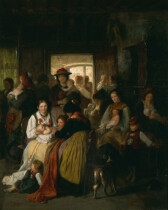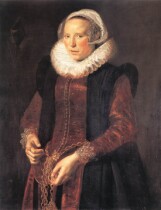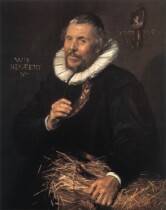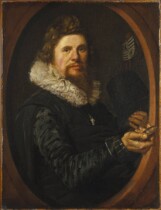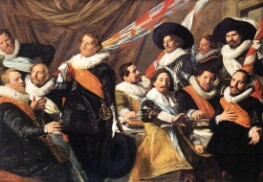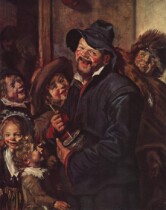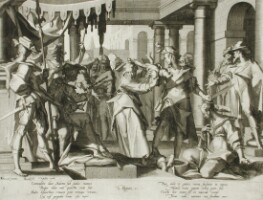The Laughing Cavalier
The Laughing Cavalier stands out among Hals’s works of male portraiture, because of the vibrant coloring and exuberant costume. The treatment and details of the painting indicate that this was a commissioned portrait for a man of high stature. Hals demonstrates his virtuosity and skill through the exquisite execution of the textures and garment details, painting the beautiful gold and silver threaded embroidery and delicate lace layers in the collar and the cuffs.
Even though the identity of the sitter is not firmly established, the painting offers helpful clues. The portrait features an inscription, which states that the subject is 26 years old, confirming that he was born in 1597 or 1598. It is also likely that he resided in Haarlem, as Hals almost exclusively portrayed citizens of Haarlem. The embroidery has motifs of arrows, oil lamps encircled by bees, that symbolize the pains and pleasures of love: the arrows pierce the heart, and the bees signify how the lovesick are drawn to the flame of love. These indicate that the man was an unmarried gentleman. The staff of mercury, another motif of embroidery, alludes to trade activities as a possible sitter’s occupation.
In recent years, the art historian Pieter Biesboer presented substantial evidence that the man in the portrait is Tieleman Roosterman, a wealthy Haarlem merchant. The identity of the sitter was narrowed through the year of birth and the assumption that he resided in Haarlem.
When examining Hals’s works of commissioned portraiture, stylistic differences are depending on the social identity and occupation of the subject. For example, when depicting Haarlem’s ruling class, in portraits such as Portrait of Jacob Pietersz Olycan (1625) and Nicolaes Woutersz van der Meer (1631), the appearance is relatively subdued. The portraits reflect their status as political leaders - their poses are static and dignified, while their costumes are simple and black. In contrast, Hals’s portrayals of the Haarlem elite were executed in a more casual and dashing style, as in Willem van Heythuyzen (1625) and Portrait of Isaak Abrahamsz Massa (1626). Expressly, Hals reserved this style for a clientele of wealthy Flemish merchants, who immigrated to Haarlem after the fall of Antwerp. The Laughing Cavalier was conceived in the same kind of style, and correspondingly Tieleman Roosterman was of a similar background and status. Most importantly, Hals painted another portrait of Roosterman 10 years after The Laughing Cavalier, in Portrait of Tieleman Roosterman (1634). Even though the men in the paintings are 10 years apart, a physical resemblance exists. The overall facial features are similar, as well as the hair and the eye color.
Interestingly, there is a small detail that can be found in both paintings, a minute scar that parts the eyebrow hair in the left eyebrow. The embroidered motifs in The Laughing Cavalier also reinforce the possibility that Roosterman is the sitter. Roosterman was indeed a bachelor at the time and a merchant by trade. Furthermore, the Roosterman’s family coat of arms has arrows on its crest and a figure that holds an arrow, making another connection between Roosterman and the decorated costume in The Laughing Cavalier.

